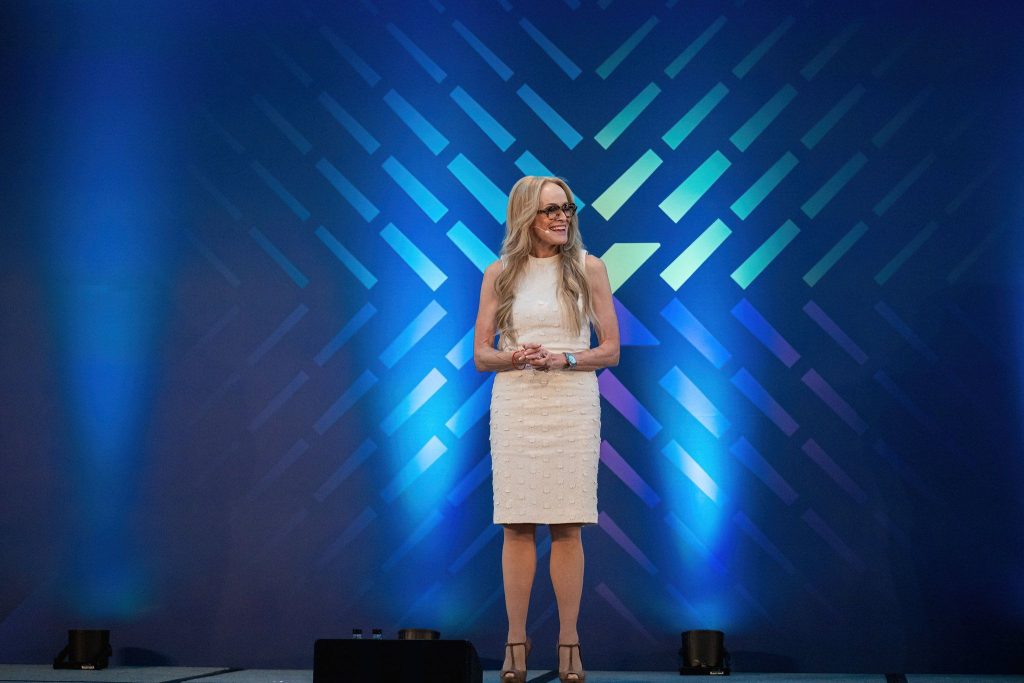At Coupa’s Inspire World Tour in London, CEO Leagh Turner unveiled the company’s transformation into an AI-native trading platform: a live, multi-sided network where buyers and suppliers interact autonomously—and every transaction trains the next.
Opening with a regional take on compliance and agility, EMEA President Joao Paulo (JP) Da Silva set the scene. Then Turner reframed Coupa’s role in the enterprise tech stack—not as an application suite, but as infrastructure for a smarter, faster, and fairer model of global commerce. Nineteen years in the making, the platform fuses permissioned customer data, real-time supply chain design, and AI-driven orchestration to trigger trades the moment conditions are met.
In a live Q&A, Rachel Montgomery-Young, Founder of SupplyChain360, spoke with Turner about Coupa’s network strategy, its AI roadmap, and the organizational shifts required to operate in a networked enterprise environment.
Rachel: You’ve spoken about building a truly interconnected platform across procurement, supply chain, and finance. What’s the strategic bet Coupa is making about how these functions need to operate differently in the next 3–5 years?
Leagh: Okay, maybe I’ll take a step back and I’ll say what do we imagine we’re doing here? What we think we’re building is a trading platform in effect. On the buyer side, obviously that goes from design to pay, so if I’m a customer, that’s my business process. On the supplier side it goes from quote to invoice, and if I’m a supplier or a buyer, that’s how I engage with this platform.
I do it through what will in future be an orchestration layer. It won’t feel like an application. It’ll feel like I can ask questions and receive answers because that orchestration layer will take the questions that are asked and it will go against a data store and return answers to either side of that trading network. And in the middle of this trading network is a giant data store.
One distinguishing feature of Coupa is that for 19 years we have had permissioned use of our customers’ data. Our customers aren’t just buyers, they’re also suppliers. We have 3,200 global customers—the vast majority of which are global multinationals—and about 10 million suppliers, 6,500 of which are unique. All of them allow us to see what they do in that network: what they price at, where they source from, to what degree they collaborate, what regulations they’re willing to trade against, and what contractual terms they’ll accept. So when you ask about how these functions come together, the answer is: if you want to buy or sell anything, there will be a network that knows who buys from whom and at what price, against whatever regulations you or I set.
If your conditions are met, the trade will execute. That’s what we’re building. So whether you’re a supply chain customer or a finance customer or a controller, it doesn’t really matter. They all need a system where if a condition is met, a transaction proceeds. We’ve approached this by building buyer processes for 19 years, by building an $8 trillion data store (growing $1.3 trillion annually), by acquiring a supplier base, and by fully integrating Llamasoft for real-time supply chain design. Now we’re applying agenda models to drive buyer-supplier collaboration and eliminate manual friction.
Rachel: In a fully connected network like the one you’re building, traditional procurement and supply chain models don’t just get faster—they get rewritten. What operating assumptions do you think leaders will have to unlearn to stay ahead?
Leagh: Yeah, I mean, I guess it’s funny. This is my eighth meeting today—the six before this and now this one—and every single customer is asking for the same thing. We shared a fully funded three-year roadmap. Chief Product & Technology Officer, Salvatore Lombardo showed a slide highlighting where AI is embedded today and where an agentic layer will be embedded in future. Over the next two years, you’ll see a proliferation of automation—the amount of transactional work done by people goes down, while system-driven work goes up. Retraining and workforce redistribution need to increase.
Customers are asking: can you bring a team that understands the tech, understands our footprint, and can help us build a plan against your roadmap? They know that this means reducing cost and labor and reallocating people to higher-order work. That’s what they want. And frankly, that’s what every technology company should be helping them do. If you’re not doing that, you’re letting your customers down.
Rachel: In a network that’s always learning and optimising, how do human skills evolve? What roles do you think procurement and supply chain leaders will need to build or reinvent to thrive in that model?
Leagh: First of all, procurement isn’t meant to be a control function. It should give people agency to make decisions. There’s an inversion happening: we want everyone in the organization to be able to make real-time decisions. They don’t need to know how to source complex categories or understand internal control frameworks. They just need to ask smart business-relevant questions. The system should handle the rest.
So the skill shift is more cultural than technical. Leaders need to say: I’m no longer the control gatekeeper; I’m here to empower. We had multiple customer meetings this week on that cultural distribution challenge. And then there’s trust. People need to trust the technology. That’s a universal struggle, but we’re working through it.
Rachel: AI is changing how procurement leaders interact with information. But trust is still a major hurdle. How are you designing AI that supports, not overrides, human judgment?
Leagh: First, AI is only as smart as the data it’s trained on. We train our AI only on our own data. Second, AI-driven technology must be trained. That changes the release process. We now release AI capabilities to small pilot customer groups who understand they are helping train the model. They don’t expect perfect results from day one. Once trained, the product becomes more broadly available. That’s the model. We have customers who want to shape how the technology behaves. It actually changes your relationship with the customer.
Rachel: A lot of companies still talk about end-to-end visibility—but most are still stuck with fragmented data and disconnected systems. What do you see as the tipping point for real integration to finally happen?
Leagh: Yeah, I mean, there’s certainly a tailwind, right? Or I don’t know if it’s a tailwind or a headwind, but like, the way that, I mean, geopolitically, the world’s changing. And as a result of that, people need to be able to make decisions faster based on a variable set of information that seems to be changing by the day. And so it doesn’t matter who you talk to, you’re talking to the same people I am.
You know, I used an example this morning, I was talking to the head of global supply chain planning at Colgate and which you would know is a very large global multinational. who said, I got to tell you, our volatility shouldn’t be our customer’s volatility. And so in essence, what she’s saying is we need more visibility in order to be able to insulate our customers from our volatility because it’s not their responsibility to absorb it. And so that I would call that a tailwind.
It means that systems consolidation is on the top of everybody’s mind. Trying to figure out how to partner with platforms that are open so that integration layers and complexity isn’t burdensome and so that you can have more agility in your decisions. Trying to figure out how to better leverage data that flows across platforms really matters. Trying to use like mega compute power like AI matters because you have to be able to surf across huge amounts of data very quickly in order to be able to get end-to-end visibility. I think that the promise is there and I think the demand is there and I think the technology is ready to meet the demand.
Rachel: You’ve seen first-hand how volatility moves from global headlines to line-item budgets. What does “agile spend management” look like at the executive level — and how are leading organisations reframing spend decisions as strategic levers rather than tactical controls?
Leagh: Yeah, I mean let’s just stop and think about like how companies grow? They grow by finding efficiency and using that efficiency in order to be able to instead of like fortifying their bottom line to use it to drive innovation. Every single customer that we speak to is saying again the same thing. Can you help us find ways to unlock inefficiency to use it to drive growth? That’s what we need.
So if we have waste in the way that we spend, meaning our spend isn’t centralized or it’s not controlled in some way or it doesn’t have proper regulations or we’re subject to penalties as a result of it, can you help us steer around those things and therefore save money? Not for the sake of fortifying our bottom line but for the sake of driving our top line.
Rachel: When budgets tighten and volatility rises, spend management becomes more political—more scrutiny, more second-guessing. How do you help leadership teams make confident decisions without slowing down?
Leagh: I had a super interesting lunch last week with a company called Valet. Valet is a global minor, one of the largest minors in the world. They have operations really across the America, sort of central and South America, the America and then up into Canada.
Obviously very mineral, rich, continent. And they for years have been able to move goods between Central and South America and the northern part of Canada against the North American Free Trade Agreement at zero tariff policy all the way from South to North. So you can imagine over the course of the last four months, they’ve been subject to a tremendous amount of volatility. They have two options in that case. They can be subject to that volatility and take the punishment of being subject to that volatility, which is impact to their bottom line, or they can find other places to source goods and to reroute the goods that they have for processing and redistribution.
And so they’ve chosen the latter, which means that they’re in no way paralyzed by the volatility that they face. And that has arguably been the most volatile part of the world over the course of the last six months. And what they’ve done actually, and I thought it was super interesting, they said, prior to COVID, we used to source globally. COVID, as you would remember, created sort of a sense of nationalism where people started to source more locally.
And then we were the beneficiary of this North American Free Trade Agreement. Now, as a result of changing tariff policies, we’re going back to a global operating model, trying to find a way to find other sources of raw goods sourcing and distribution. And I don’t know, it’s forced them to action as opposed to like, I don’t know, being paralyzed. So that’s what’s going on. I think lots and lots of companies in the face of volatility are moving to action.
Rachel: You’ve led complex global organisations through transformation. What advice would you give to leaders trying to drive change while still bringing their teams with them?
Leagh: I think just maybe three things. First, maybe it’s really one thing. Geopolitically, macroeconomically and technically, we are in a period of massive change. You can either be completely paralyzed by those three, like the confluence of those things, or you can see them as a tremendous opportunity. And we have, I don’t know, plus or minus 400 people here, and none of them showed up because they’re paralyzed. Like every single one of them are here because they think that there’s an opportunity to move faster. And I think that that’s super encouraging. So I don’t know that they need me to tell them anything.
I think that they feel like emboldened to go and affect some change, and they can see that these things coming together are a real tailwind and an opportunity. And I said this this morning, but I’ll say it again.
I said at BCG, BCG says, many large consultancies do, that transformations during periods of real volatility succeed more than in periods of more stasis. And the reason they do, I think, is because you’ve got to like reason. And so, you know, if you show up and you say, hey, geopolitically, things are changing. We’re gonna be subject to penalties that we could have never imagined. We got to make some changes. People will move.
If you show up and say, hey, technically, this is going to break Moore’s law, right? AI is going to be totally transformative, and we’ve gotta change our workforce. People will move. If you show up and you say, we’re gonna be subject to all kinds of penalties that we could have never imagined, and macroeconomically, we’re gonna suffer, we’ve gotta move.
As Coupa repositions itself as a fully integrated trading platform, the conversation with Leagh Turner offered a grounded look at what that shift means for enterprise operations. The future isn’t just about automating transactions, it’s about rethinking how decisions are made, how functions collaborate, and how volatility becomes a catalyst rather than a constraint.







